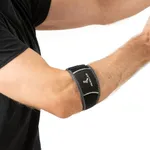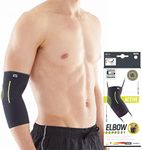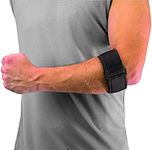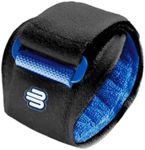Buying Guide for the Best Tennis Elbow Straps
When choosing a tennis elbow strap, it's important to consider how it will support your arm and alleviate pain. The right strap can help reduce strain on your elbow by applying pressure to the forearm muscles, which can be beneficial for those suffering from tennis elbow or similar conditions. The key is to find a strap that fits well, is comfortable to wear, and provides the right level of support for your needs. Consider your activity level, the severity of your condition, and any specific features that might enhance your comfort and recovery.MaterialThe material of a tennis elbow strap is crucial because it affects comfort, durability, and breathability. Common materials include neoprene, nylon, and cotton blends. Neoprene is known for its durability and ability to provide firm support, but it can be less breathable. Nylon is lightweight and often more breathable, making it suitable for extended wear. Cotton blends offer comfort and breathability but may not provide as much support. Choose a material based on how long you plan to wear the strap and your comfort preferences, especially if you have sensitive skin or plan to wear it during physical activities.
AdjustabilityAdjustability refers to how well you can customize the fit of the strap to your arm. This is important because a well-fitted strap will provide better support and comfort. Most straps come with Velcro closures or buckles that allow you to adjust the tightness. Some may have multiple adjustment points for a more tailored fit. If you have fluctuating swelling or plan to use the strap during different activities, look for a highly adjustable strap to ensure it remains effective and comfortable.
Compression LevelThe compression level of a tennis elbow strap determines how much pressure it applies to your forearm muscles. This is important for reducing strain and alleviating pain. Compression levels can range from light to firm. Light compression is suitable for mild discomfort or preventative use, while firm compression is better for more severe pain or during intense activities. Consider your pain level and activity type when choosing the compression level. If you're unsure, a moderate compression level is a good starting point, as it offers a balance between support and comfort.
Size and FitSize and fit are critical for the effectiveness of a tennis elbow strap. A strap that is too tight can restrict circulation, while one that is too loose may not provide adequate support. Many straps come in different sizes or are one-size-fits-all with adjustable features. To find the right size, measure the circumference of your forearm just below the elbow. Ensure the strap you choose can accommodate your measurement. A proper fit will ensure the strap stays in place during activities and provides consistent support.
Design and FeaturesThe design and additional features of a tennis elbow strap can enhance its functionality and comfort. Some straps have a simple band design, while others include a pad or gel insert that targets pressure on specific areas. Features like moisture-wicking fabric, antimicrobial properties, or reflective elements for visibility can also be beneficial. Consider what features are important for your lifestyle and needs. For example, if you sweat a lot during activities, a moisture-wicking strap might be ideal. If you need targeted pressure, look for a strap with a built-in pad.


















